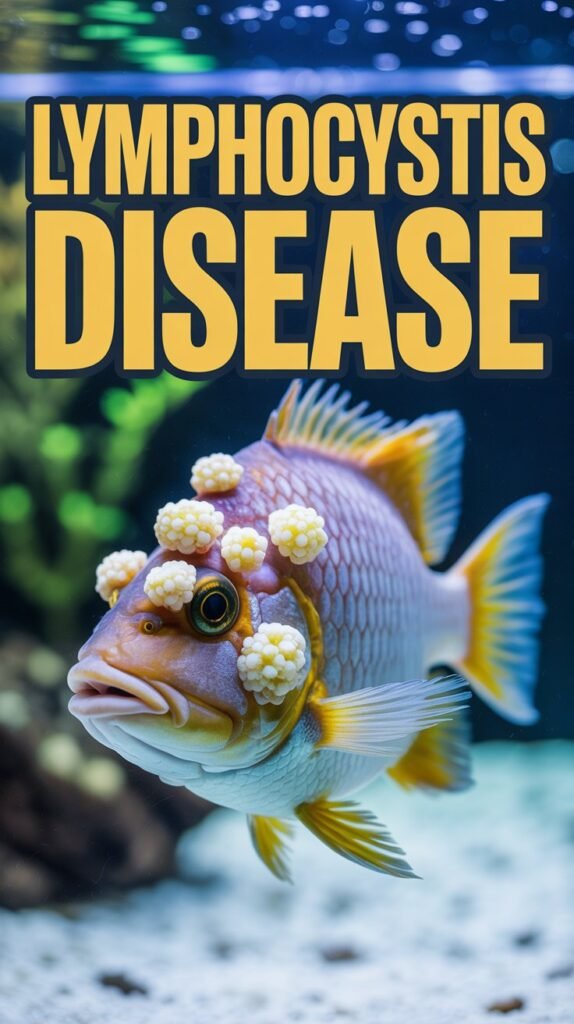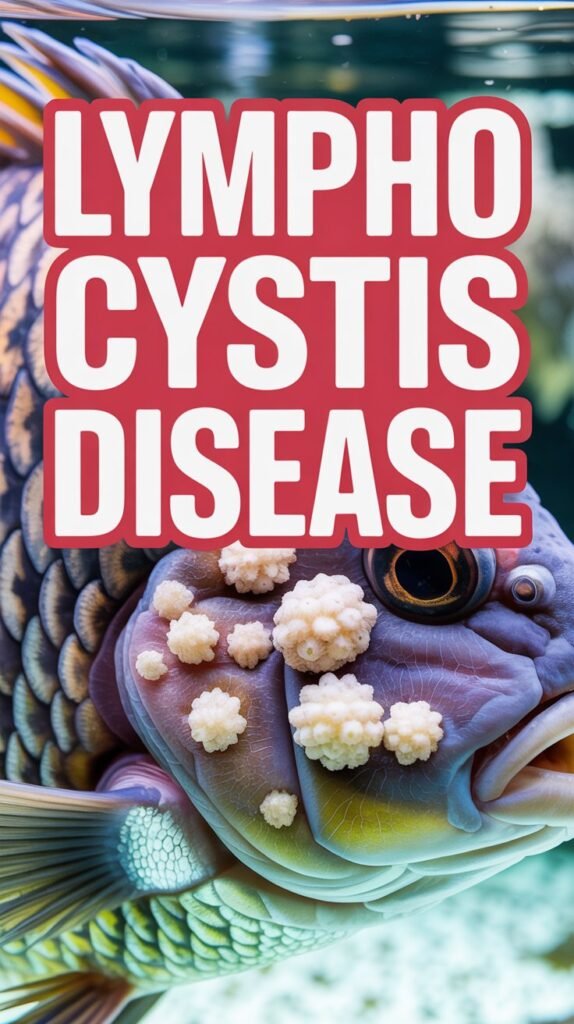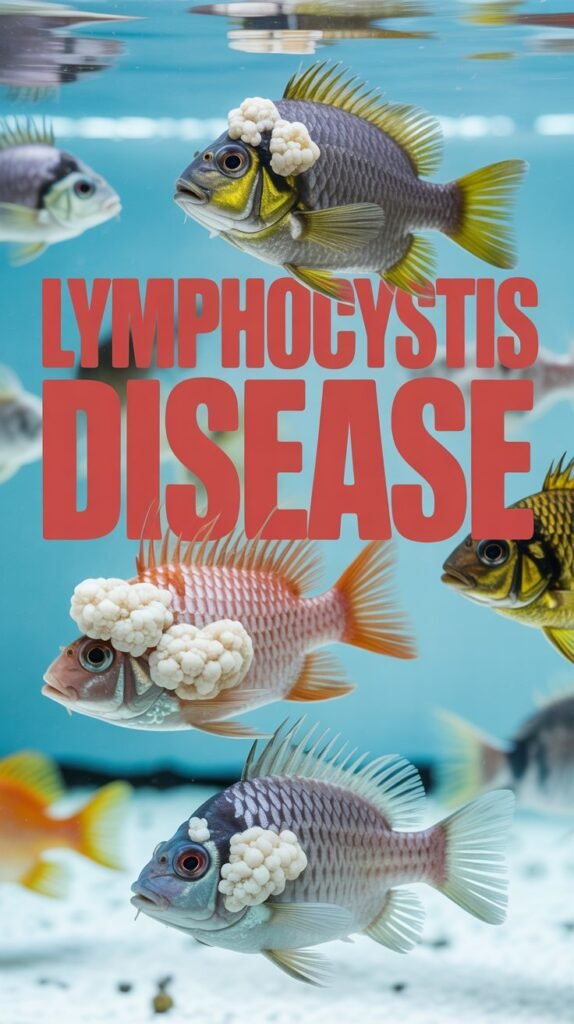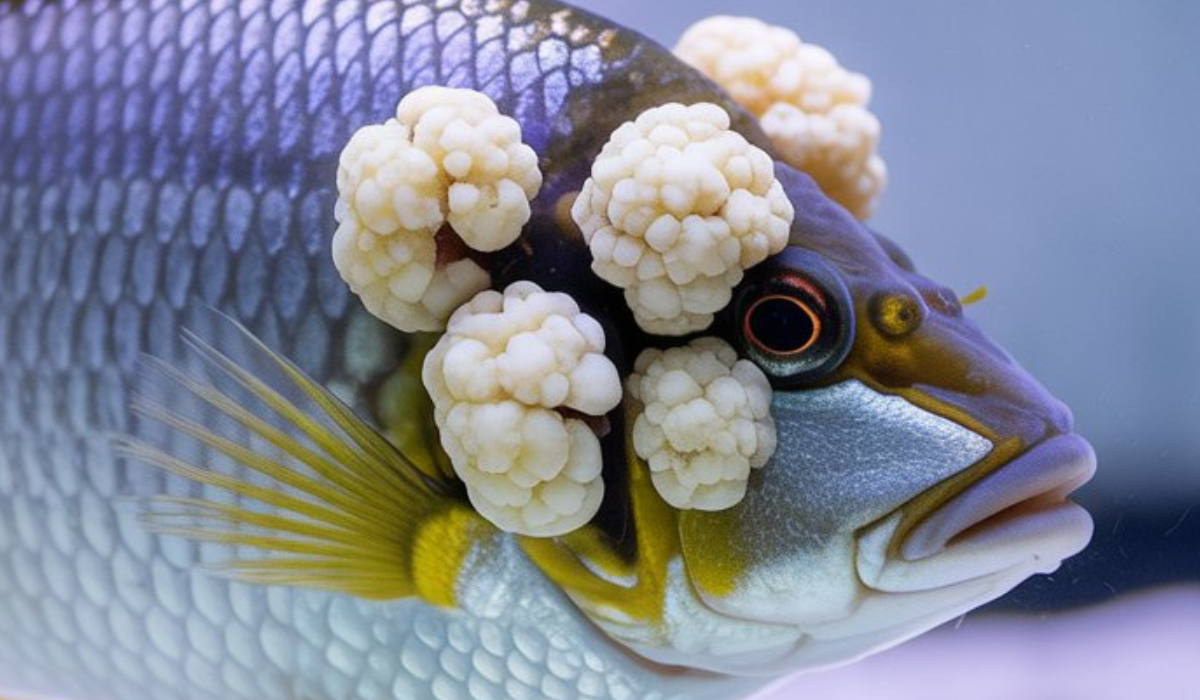Lymphocystis disease is one of the most common viral infections that affect both freshwater and marine fish. It’s a non-lethal yet disfiguring condition that can cause great concern for aquarium hobbyists and fish farmers. The disease is caused by a virus belonging to the Iridoviridae family, known as Lymphocystivirus. While it usually doesn’t kill the host fish directly, it can lead to secondary infections, stress, and overall poor health if left unmanaged.
In this comprehensive guide, we’ll explore everything you need to know about lymphocystis disease—from its causes and symptoms to its treatment and prevention. Whether you’re a hobbyist maintaining a home aquarium or a professional managing a fish farm, understanding this viral infection is essential for protecting your fish population.
What Is Lymphocystis Disease?
Lymphocystis disease is a chronic viral infection that causes the formation of white to pinkish nodules on the skin, fins, or gills of fish. These nodules are the result of hypertrophied (enlarged) cells known as lymphocystis cells. They give the fish a wart-like or cauliflower-like appearance, often leading to aesthetic deformities.
Although the condition looks alarming, it’s rarely fatal. However, it can compromise the fish’s immune system, making it more susceptible to bacterial and fungal infections.
Causative Agent: The Lymphocystivirus

The causative agent of lymphocystis disease is Lymphocystivirus, a DNA virus belonging to the Iridoviridae family. It infects a wide range of freshwater and marine species. The virus targets fibroblasts in the connective tissues, leading to cell enlargement and the formation of visible nodules.
Characteristics of the Lymphocystivirus:
- Virus Family: Iridoviridae
- Genus: Lymphocystivirus
- Genome: Double-stranded DNA
- Transmission: Direct contact or via contaminated water, equipment, or infected fish
The virus is highly stable in aquatic environments, which allows it to persist for weeks, especially in tanks with poor water quality.
Susceptible Fish Species
Lymphocystis disease affects over 140 species of fish worldwide. Both ornamental and food fish can contract the virus. Some of the most commonly affected include:
Freshwater Fish:
- Guppies (Poecilia reticulata)
- Angelfish (Pterophyllum scalare)
- Gouramis (Trichogaster spp.)
- Bettas (Betta splendens)
- Cichlids (Cichlidae family)
- Catfish (Corydoras spp.)
Marine Fish:
- Flounder
- Groupers
- Wrasses
- Snapper
- Gobies
Juvenile and stressed fish are generally more vulnerable to infection than adult, healthy individuals.
Causes and Transmission
The lymphocystis virus is highly contagious among fish populations, although it doesn’t spread rapidly like bacterial diseases. Transmission typically occurs through:
- Direct Contact: Healthy fish can contract the virus by touching infected individuals.
- Waterborne Spread: The virus can persist in the water and infect fish through skin abrasions or gills.
- Contaminated Equipment: Nets, siphons, and other tools used in multiple tanks can transfer the virus.
- Stress Factors: Poor water quality, overcrowding, and abrupt temperature changes can weaken fish immunity, increasing susceptibility.
Once the virus infects a fish, it enters the fibroblasts and replicates slowly, often taking weeks to produce visible signs.
Symptoms of Lymphocystis Disease

Recognizing lymphocystis disease early is key to managing its spread and minimizing damage. The symptoms develop gradually and vary depending on the fish species and the infection site.
Common Signs Include:
- White or Pinkish Nodules:
These nodules appear on fins, skin, or gills and resemble small pearls or warts. - Cauliflower-like Growths:
As the infection progresses, the nodules can merge into large, irregular, cauliflower-shaped clusters. - Fin Erosion:
The fins may appear ragged or frayed if the nodules develop along the fin rays. - Reduced Activity:
Infected fish often become less active and may isolate themselves. - Difficulty Breathing:
If the gills are affected, fish may show labored breathing or gasp at the water surface. - Loss of Appetite:
Some fish may eat less due to stress or physical discomfort.
Important Note:
These growths are not fungal or bacterial infections. Many hobbyists mistakenly treat lymphocystis as “fungus” due to its white appearance, but antifungal medications will not work against this viral disease.
Pathogenesis: How the Virus Works
Once the lymphocystivirus enters the host, it infects connective tissue cells, especially fibroblasts. The viral DNA instructs these cells to grow abnormally large (hypertrophy), sometimes increasing their size by over 100 times the normal diameter. This enlargement leads to visible nodules.
Over time, these infected cells may rupture, releasing viral particles into the water, where they can infect other fish. The disease generally follows a slow progression, with outbreaks often lasting several weeks to months.
Diagnosis
Accurate diagnosis is essential to distinguish lymphocystis disease from other similar conditions such as bacterial granulomas or fungal infections.
Methods of Diagnosis:
- Visual Observation:
The cauliflower-like nodules are often distinctive enough for a presumptive diagnosis. - Microscopic Examination:
Scraping the lesion and examining it under a microscope will reveal enlarged cells (lymphocystis cells) with a central nucleus and basophilic inclusions. - Histopathology:
Tissue samples can confirm the presence of hypertrophied fibroblasts typical of lymphocystis infection. - Molecular Testing (PCR):
Polymerase Chain Reaction (PCR) can be used to detect viral DNA, though it’s more common in research or commercial aquaculture facilities than in home aquariums.
Treatment of Lymphocystis Disease
Unfortunately, there is no direct antiviral medication available for lymphocystis disease. Since it’s a viral infection, treatment focuses on supportive care and creating conditions that help the fish’s immune system fight off the virus naturally.
1. Improve Water Quality
Maintaining pristine water conditions is the most effective step in managing lymphocystis. Regular water changes, stable temperature, and proper filtration reduce stress on fish and promote healing.
- Temperature: Keep within the species’ ideal range.
- pH: Maintain stable and appropriate levels.
- Ammonia/Nitrite: Keep at 0 ppm.
- Nitrate: Below 20 ppm is ideal.
2. Isolate the Infected Fish
Quarantine affected fish in a separate tank to prevent spreading the virus to healthy ones. Use dedicated equipment for this tank to avoid cross-contamination.
3. Nutrition and Immune Support
Feed high-quality, vitamin-rich foods to boost immunity. Supplement with:
- Vitamin C
- Vitamin E
- Spirulina
- Garlic-based foods
A strong immune system allows fish to suppress the virus more effectively.
4. Gentle Lesion Management
If nodules are large and causing difficulty in swimming or feeding, some aquarists may carefully trim them using sterilized tools. However, this should be done only by experienced individuals and under proper conditions to prevent injury and secondary infection.
5. Secondary Infection Control
Apply mild antiseptics like iodine or methylene blue to prevent bacterial or fungal infections at lesion sites. Avoid strong chemicals that could harm already weakened fish.
Prognosis
The prognosis for lymphocystis disease is generally favorable. Many fish recover fully once environmental conditions improve and the immune system suppresses viral activity. Lesions may regress spontaneously over several weeks to months. However, in some chronic cases, the fish may remain carriers even after apparent recovery.
Prevention of Lymphocystis Disease

Prevention is the best approach when dealing with lymphocystis, as it is far easier to avoid than to cure. A few simple but effective measures can help protect your fish:
1. Quarantine New Fish
Always isolate new fish for at least two weeks before adding them to your main tank. This helps detect early signs of disease and prevents introducing the virus to healthy fish.
2. Disinfect Equipment
Clean and disinfect nets, siphons, and other equipment before using them in different tanks.
3. Maintain Optimal Water Conditions
Good water quality is the foundation of fish health. Regular testing and maintenance reduce stress and susceptibility to infections.
4. Avoid Overcrowding
Too many fish in one tank leads to stress and increases the likelihood of disease transmission.
5. Reduce Stress
Keep the environment stable. Avoid sudden temperature changes, aggressive tankmates, or unnecessary handling.
6. Balanced Diet
Feed a varied and nutritious diet to strengthen the fish’s immune defenses.
Differences Between Lymphocystis and Other Fish Diseases
| Feature | Lymphocystis Disease | Fungal Infection | Bacterial Infection |
|---|---|---|---|
| Cause | Virus (Lymphocystivirus) | Fungus (Saprolegnia) | Bacteria (Aeromonas, Pseudomonas) |
| Appearance | White/pink nodules, cauliflower-like | Cottony or fuzzy white patches | Ulcers, redness, open sores |
| Treatment | Supportive care | Antifungal medications | Antibiotics |
| Fatality Rate | Low | Moderate | High if untreated |
This comparison helps aquarists identify lymphocystis more accurately and avoid unnecessary or ineffective treatments.
Lymphocystis in Wild vs. Captive Fish
In wild fish populations, lymphocystis outbreaks are sporadic and typically self-limiting due to natural selection and environmental balance. However, in aquaculture and ornamental fish systems, confined spaces and high stocking densities facilitate viral spread.
Captive fish are also subject to stress factors like poor water quality and handling, which increase vulnerability to infection. Therefore, management in aquariums and fish farms requires stricter biosecurity practices.
The Economic and Aesthetic Impact
Although lymphocystis disease rarely causes mass mortality, it can significantly reduce the commercial value of ornamental and food fish. Disfigured fish are often considered unsellable in the ornamental trade. In aquaculture, the disease can lead to production losses and additional costs for isolation and maintenance.
For hobbyists, seeing their prized fish develop unsightly lesions can be distressing. Fortunately, with proper care and patience, many fish can recover fully and regain their beauty.
Lymphocystis Disease Life Cycle
The virus life cycle in fish follows several stages:
- Attachment and Entry: The virus attaches to fibroblast cells in the skin or fins.
- Replication: The viral DNA replicates within the host cell nucleus.
- Cell Hypertrophy: Infected cells grow abnormally large, forming nodules.
- Rupture and Release: The cell bursts, releasing new viral particles into the water.
- Transmission: The virus infects new hosts through direct contact or waterborne spread.
Understanding this cycle helps in implementing effective control measures, such as isolation and improved hygiene.
Can Humans Get Lymphocystis?
No, lymphocystis disease is not zoonotic. The virus is specific to fish and poses no threat to humans or other animals. It cannot infect through handling or water contact.
However, good hygiene practices—such as washing hands after handling fish or tank water—are always recommended.
FAQs About Lymphocystis Disease
1. What causes lymphocystis disease in fish?
Lymphocystis disease is caused by the Lymphocystivirus, a DNA virus from the Iridoviridae family. It spreads through direct contact or contaminated water and equipment.
2. Is lymphocystis contagious?
Yes, it’s contagious among fish but spreads relatively slowly. Infected fish should be isolated to prevent transmission.
3. Can lymphocystis disease kill fish?
The disease itself is rarely fatal. However, it can lead to secondary infections or severe stress, which may cause death in weakened fish.
4. How long does lymphocystis take to heal?
Recovery can take several weeks to months, depending on the fish’s immune strength and environmental conditions.
5. Can I use antibiotics to treat lymphocystis?
No. Since it’s a viral disease, antibiotics will not help. Focus instead on improving water quality and boosting immunity.
6. Should I remove infected fish from the tank?
Yes, quarantine infected fish to stop the virus from spreading. Provide supportive care in a separate, clean environment.
7. Will lymphocystis come back?
Recovered fish may remain carriers of the virus. Stressful conditions can sometimes trigger recurrence.
8. How can I prevent lymphocystis in my aquarium?
Quarantine new fish, maintain excellent water quality, disinfect equipment, and provide a nutritious diet to reduce risk.
9. Is lymphocystis the same as fungal disease?
No. Lymphocystis is viral, while fungal diseases are caused by organisms like Saprolegnia. They look similar but require different management.
10. Can lymphocystis affect eggs or fry?
The virus primarily affects juveniles and adults, but fry in poor water conditions may also become infected if exposed.
Conclusion
Lymphocystis disease may look severe, but with proper care and understanding, it can be effectively managed. The key lies in maintaining excellent water conditions, providing balanced nutrition, and preventing stress. Since there is no specific cure, prevention and supportive care remain the best strategies.
For aquarists and fish farmers alike, awareness of lymphocystis disease ensures healthier, more resilient fish populations and a more rewarding aquarium experience. With patience and the right approach, even infected fish can recover their strength and beauty.
Lymphocystis Disease

